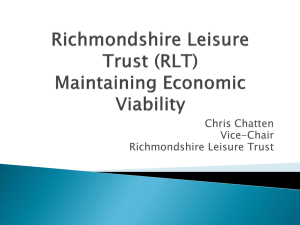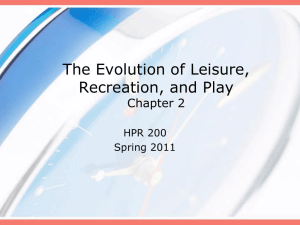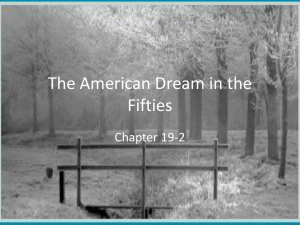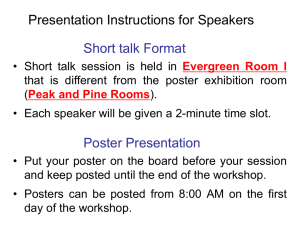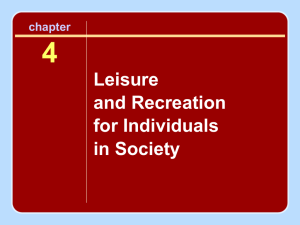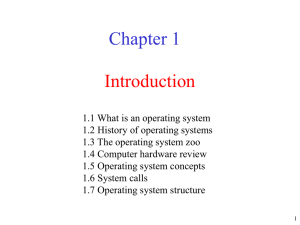Presentation
advertisement
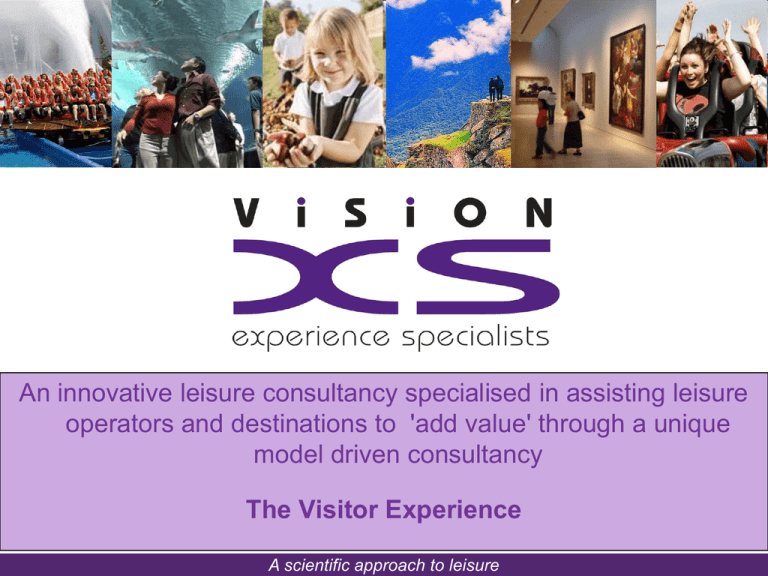
An innovative leisure consultancy specialised in assisting leisure operators and destinations to 'add value' through a unique model driven consultancy The Visitor Experience A scientific approach to leisure Who we are… Introducing Vision XS • Founded in 1993 • Representation in 6 countries, head office near Oxford in UK • Specialist consultancy service advising leisure and attraction operators, destinations and developers internationally • Vision XS provides a unique scientific approach to evaluating and shaping the visitor experience • Vision XS offers a multidisciplinary team of highly skilled consultants, psychologists and researchers A scientific approach to leisure Clients and projects Zoos/Aquaria Shows/Events 2 Oceans Aquarium Bristol Zoo Gardens Colchester Zoo Detroit Zoo South-Africa UK UK USA Dudley Zoo Edinburgh Zoo Living Coasts Marwell Zoo National Aquarium Baltimore Paradise Wildlife Park Port Lympne Zoo Pretoria Zoo Shedd Aquarium Slimbridge Ushaka Marine World Woburn Safari Park Zoo Hannover Twycross Zoo UK UK UK UK USA UK UK South-Africa USA UK South-Africa UK Germany UK Arabian Show Hit Entertainment Scooby Doo Walsall Illuminations Erlebniswelt Fashion Hotel UAE UAE UK UK Germany UAE Floriade 2012 Global Village Orca Whale watching Table Mountain Cableway Netherlands UAE UK South-Africa Family Entertainment Centers Dunes Project Jump Kids Play Noah’s Ark A scientific approach to leisure UAE UK UK UK Clients and projects Farm Parks Historic Visitor Attractions Stirling Castle Warwick Castle UK UK Theme Parks Blackpool Pleasure Beach Crealy Adventure Park, Devon & Cornwall Freej Park Gold Reef City Legoland Paulton’s Park Southampton Portugal Fantasia Six Flags Dubai Universal Studios UK UK UK UAE SA Germany UK Portugal UAE UAE Alice in Wonderland Barleylands Big Sheep Bucklebury Farm Cantref Cotswold Farm Park UK UK UK UK UK UK Fishers Farm Greenwood Forest Park Marsh Farm Obst-Erlebnis-Garten, Baltic Farm Park Odds Farm Park Pennywell Farm Park Spring Barn Tulleys Farm UK UK UK Germany UK UK UK UK Union Farm Wild Britain Willows Farm Park Windmill Farm Park York Maze UK UK UK UK UK A scientific approach to leisure Clients and projects Sports EDAW – legacy planning London Olympics 2012 Newbury Race Course Hamburg Football Club The Tote (betting experience analysis) Soccer City 2010 Johannesburg Fan Park Planning 2010 2012 Olympic Mountain Biking Legacy Plan 2012 Olympic White Water Legacy Plan ISPO Sport Exhibition Munich A scientific approach to leisure UK UK Germany UK South Africa South Africa UK UK Germany Clients and projects Museums/Science Centres American Museum of Natural History Ballinstadt Auswandererwelt Dornier Museum Frazier International History Museum Imperial War Museum MTN Science Centre Cape Town USA Germany Germany USA UK South-Africa Museum of Science & Industry, Air & Space National Needlework Museum Redditch Natural History Museum (Antarctica exhibition) Natural History Museum (Dino Birds exhibition) Old World Wisconsin Pendon Museum Wallingford Museum UK UK UK UK USA UK UK Bletchley Park Urquhart Castle UK Scotland A scientific approach to leisure Pressing the Psychological Buttons for Maximum Experience A scientific approach to leisure Benefits – Strengths and Weaknesses through metrics WHAT ARE THE KEY PARAMETERS OF A VISITOR EXPERIENCE. HOW CAN THEY BE MANAGED FOR OPTIMUM RESULTS • What are the Key Parameters • How can they be measured and then managed • What are the Key Dynamics to achieve optimum results • What is the relationship between the Visitor Experience and Revenue A scientific approach to leisure The Experience The Visitor Experience Visitor Flow Learning Capability Experience Quantity Experience Quality Experience Value for Money Capacity Effectiveness Psychological Appeal A scientific approach to leisure Psychographic data base Vision XS works from the basic premise that all human experiences can be dissected into a sequence of qualitative and quantitative psychological elements. These elements are used to model psychological profiles of potential customers in markets that focus on attitudes, interests, personal opinions and preferences. A scientific approach to leisure Psychographic data base • Psychographic data is data that links objective demographic characteristics like age and gender with more abstract characteristics related to ideas, opinions and interests. • Psychographics identify personality characteristics and attitudes that affect a person's lifestyle and purchasing behaviour. • Psychographic data can be gathered first-hand through personal interviews, focus group interviews or questionnaires, or purchased from research companies. A scientific approach to leisure Psychographic Element Groupings Skills and Senses Emotion or Reaction Motion Learning The Surroundings Action and Activity A scientific approach to leisure Our unique data base The world’s largest experiential database meets the most sophisticated modelling software. X-Mod is driven by three types of data: ◘ General population psychographic data collected in each target market country. Data is already collected in: ♦United Kingdom ♦Germany ♦Portugal ♦Poland ♦Australia ♦UAE ♦Iran ♦Pakistan ♦Egypt ♦Finland ♦USA ♦South Africa ♦China ♦Singapore ♦Russia ♦India ♦Holland ♦Romania Tracking studies data base. ◘ Benchmarking data base that incorporates results data from the analysis of over 110 projects. A scientific approach to leisure Component elements - example For example the Olympic way in Athens contained the following elements: • On or near water • Passion for your country or region • Emotional • Inspiring • Themed area • Visual Effects • Sounds Effects Olympic Way, Athens A scientific approach to leisure What is X – MOD? • X-MOD is an experience modelling tool developed by mathematicians, psychologists, statisticians and market researchers. It is operational in 16 countries and has already been used by over 110 facilities and two destinations. • X-MOD offers a clear picture of the strengths and weaknesses of the visitor experience on offer, along with analytical evidence to define, direct, and support a dynamic solution. • It measures eight parameters of visitor enjoyment: Visitor flow Experience intensity Experience quality Experience quantity Capacity effectiveness Experience value Learning capability Psychological appeal A scientific approach to leisure How easy is it to predict the visitors route through your attraction? Impossible Difficult Easy 0% 44% 56% A scientific approach to leisure Do you manage the visitors journey time in any way? Yes No Sometimes 16% 25% 59% A scientific approach to leisure How much of your experience changes each year? Always the same 17% A little A lot 3% 80% A scientific approach to leisure TThe How to improve visitor flow. Minimise queue times. Better navigation of the site. Position toilets, restaurants, kiosks. Direction for stra tegies and plans for any future additions to the attraction. A scientific approach to leisure 0 A scientific approach to leisure Top Secret - The Ending of War - Behind the Scenes Tour The People of BP - Characters 1940's Show Stage Spies Tour and Workshop Hut 12 - exhibition Block H - exhibition The History of Computing - Tour Billets - exhibition Off Duty - exhibition Hut 8 - exhibition Women at War - tour Pigeons at War - exhibition Vintage Cars Display - exhibition The Country House at War - The Rise of Radio - exhibition Hut 1 - exhibition The History Of Radio - Tour Post Office A History of Cods and Chipers The Polish Memorial Garden Hut 11 - exhibition Hut 6 - exhibition Hut 3 - exhibition Code Breacking - Tour Recruitment and Choice of BP History of BP - exhibition The Build Up To The War - intro Element count Typical visitor journey for age 41 - 65 A typical psychological journey for visitors age 41-65 35 30 25 20 15 10 5 35 30 25 20 15 10 5 0 A scientific approach to leisure Top Secret - The Ending The People of BP - 1940's Show Stage Spies Tour and Hut 12 - exhibition Block H - exhibition The History of Billets - exhibition Off Duty - exhibition Hut 8 - exhibition Women at War - tour Pigeons at War - Vintage Cars Display - The Rise of Radio - Hut 1 - exhibition The History Of Radio - Post Office A History of Cods and Hut 11 - exhibition Hut 6 - exhibition Hut 3 - exhibition Code Breacking - Tour History of BP - exhibition The Build Up To The War Element count Typical visitor journey for age 17 - 25 Typical visitor journey age 17-25 Dwell Time vs Experiences per Hour 6 5.5 Dwell time (hours) 5 Optimal 4.5 4 3.5 Boredom 3 2.5 Burnout 2 1.5 1 0 1 2 3 4 5 6 Experiences per hour A scientific approach to leisure 7 8 9 10 Active time Active time Age group Survey active time Benchmark active time Site active time 0-2 40.8 40.8 48.7 50 3-5 40.1 42.1 49.9 40 6-10 41.6 44.1 49.4 11-16 41.9 40.7 39.6 20 17-25 39.4 44.4 38.6 10 26-40 41.1 49.1 42.5 41-65 39 48.4 42.4 66+ 34.4 48.3 38.7 Active time Active time(%) Survey data 60 Active time (%) * * 30 0 0-2 3-5 6-10 11-16 17-25 Age group 26-40 41-65 66+ The time ‘active’ i.e. in exhibits, rides, talks etc is fairly close to the ideal. This should be maintained through and after the future planned developments. *Survey data is the world’s largest database of its kind, storing vast amounts of data on psychological and leisure needs of different populations and age groups (8 age groups, 16 countries, 25,600 surveys), A scientific approach to leisure Active Time: Major theme park in Dubai Before Project Amenities inc. queues 13% After Project Active 14% Amenities inc. queues 17% Active 28% Transient 16% Transient 25% Queuing 33% Spectating 14% Queuing 25% Spectating 15% Here this major new theme parks first design was only delivering 14% of a visitors day ‘Active’ (on the rides and in shows) whereas after design changes around 28% was achieved. Result – much happier customers A scientific approach to leisure Do you measure average dwell time? Yes No 44% 56% A scientific approach to leisure Average Catering Spend vs Average Dwell Time £5.00 Average catering spend £4.50 £4.00 £3.50 £3.00 £2.50 £2.00 £1.50 £1.00 £0.50 £0.00 0 1 2 3 4 Average dwell time (hours) A scientific approach to leisure 5 6 7 Learning Styles Learning styles Learning styles 70 Style (% on site) 60 50 40 30 20 10 0 Creative Reading Talking Practical The mix of learning styles offered by a day out at XXX does not reflect how the UK population want to access the experience. Whilst the amount of learning via reading is perfect, the most popular method of creative learning is barely reflected and needs rectification in future plans. A scientific approach to leisure Experience Quality EQS Experience quality Quality Benchmark data World class 200 * 180 160 Quality 140 120 100 80 60 40 20 0 0-2 3-5 6-10 11-16 17-25 26-40 41-65 66+ Age group The psychological quality of the experience offered is in the red ‘unacceptable’ band and is below the zoo benchmark quality for all but the 3-5 year olds. Adding the elements in the next table will make a big difference to this result. *Benchmark data is the data taken from 100+ real attractions across the globe; their quality of experience A scientific approach to leisure Psychographic elements to add The list identifies the missing psychographic elements and should be use in design phase to create new experiences that will psychologically appeal to young age groups. 0-2 3-5 6-10 11-16 1 Visual effects Push buttons and pull levers Physical activity Rides / machines that you control 2 Sound effects Physical activity Futuristic Physical activity 3 Push buttons and pull levers Relaxing Spending money Extreme motion 4 Physical activity Touching something rare Fast motion Fast motion 5 Touching something rare Futuristic Push buttons and pull levers Relaxing 6 Staff who talk to you Visual effects Artistic activities Going round and round 7 Themed areas Spending money Relaxing Spending money 8 Tasting Themed areas In water or getting wet Simulated motion 9 Relaxing Sound effects Being close to or on water Learning by being creative 10 Viewing something rare Interactive computer displays Extreme motion Futuristic 11 Artistic activities Smelling Going round and round Fantasy 12 Smelling Artistic activities Rides / machines that you control In water or getting wet A scientific approach to leisure Key capacities The indoor capacity at 81% is fine, although many of these experiences are very similar. Key capacities Percentage of total capacity (%) Indoor capacity 81.4 Repeatable capacity 9.5 Water capacity 3.7 Show capacity 1.9 Spend capacity 3.1 The repeatable capacity is very low and will need to improve to 30+% in order for the zoo to reach its desired market penetration. As water remains popular with all ages and all populations, the Water capacity needs improving to 10+% to be in line with modern zoo experiences. The demonstration (show) capacity is very low and requires increasing to 10-15% of the total capacity on the site. The spend capacity should never go above 5%. A scientific approach to leisure Experience value Experience value Experience value Value(GBP) Ticket price Benchmark data 12 Value(GBP) 10 8 6 4 2 0 0-2 3-5 6-10 11-16 17-25 26-40 41-65 66+ Age group Currently XXX represents reasonable value for children and very poor value for adults. A scientific approach to leisure Benefits – Strengths and Weaknesses through metrics • Master Planning • Analysing Concepts • Capital Investment Appraisal • De-risking by modelling different ideas • Shaping even more detailed briefs to designers • Operational Quick Wins • Capacity Effectiveness • Benchmarking A scientific approach to leisure THANK YOU Chris Webster Chief Executive Vision XS Ltd Abingdon, Oxford, UK OX14 3YS +44 (0)1235 420327 M: +44 (0)7787 563392 chrisw@visionxs.co.uk www.visionxs.co.uk A scientific approach to leisure
